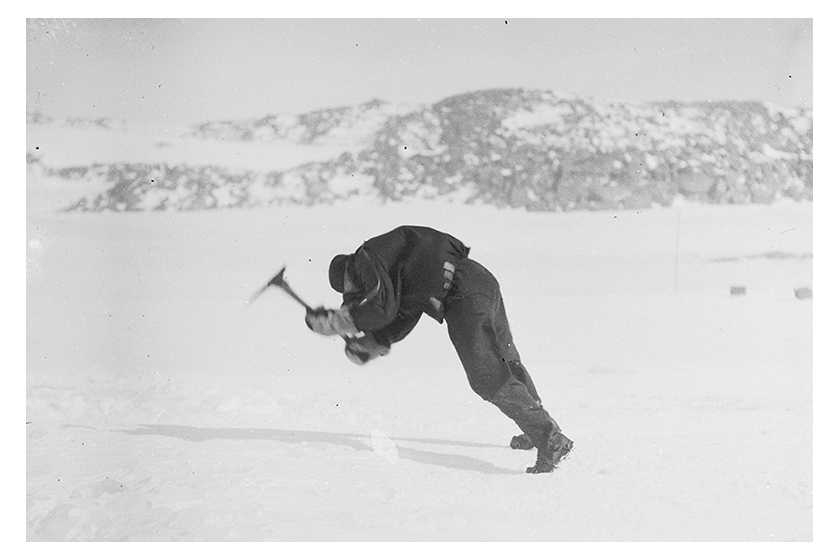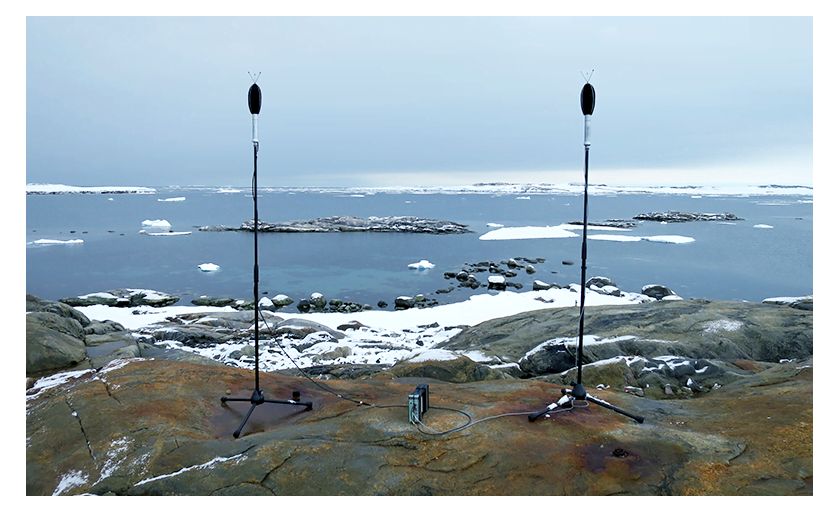My project emerges from a fascination with the innovative photography of Herbert Ponting and Frank Hurley, who by combining subject, composition and climate conveyed a deeply mysterious and alien place. I am particularly intrigued by Hurley’s depictions of life on the ice through two iconic photographs, The Blizzard and Leaning on the Wind, both taken in 1912. The photographs convey the ferocity and atmospheric effects of the conditions using a mix of techniques including staged scenes and composite printing to viscerally express something that is close to impossible to articulate through conventional documentary photography. Inspired by these evocative depictions of abstract landscapes that have been shaped by volatile conditions, I wondered how I could produce an equivalent account using sound recording techniques to render an embodied experience of extreme climate.

The katabatic effect on sound
With images of ferocious gales and phantasmagorical landscapes etched firmly into my mind, I undertook three weeks of fieldwork at Casey Station in Eastern Antarctica, interrogating the effects of katabatic wind on the station and surrounding environment. Katabatic wind is a low gravity wind that gains force as it travels down elevated slopes. It is particularly prevalent at Casey due to its location at the base of Law Dome, which gently rises to an elevation of 1395 meters. When the cooler temperature of a katabatic wind mixes with the warmer temperature of the onshore wind, an erratic weather system emerges, making Casey the ideal location for my project.
Katabatic wind is particularly notable for the way it shapes the manner in which sound is experienced within the built and natural environment. Its trajectory can push sound away from you or it can draw it closer to you. Its intensity can mask sound and its absence can heighten it. At its most ferocious, it simply obliterates everything in its path. A collision with the built environment transforms katabatic wind into an intense series of ascending and descending pitches – a supercharged aeolian harp. Inside the steel-framed and insulated-panel buildings, pervades a silence that imposes a profound sense of isolation from the immediate environment.
Outside, the volatility is expressed through a variety of resonances emitted by miscellaneous surfaces and materials undergoing tremendous stress. On one occasion, while recording from an ice-encrusted, cold porch, I am informed that wind gusts are exceeding 185 km/h. The piercing shrieks of the anemometer emerging from the white abyss provide testimony to its ferocity.
Extreme symphony
Over three weeks, I recorded an assortment of sound activated by wind and shaped by the cold. Ice granules dancing across sheet metal, agitated flags, murmuring cables, brittle plastic sheets billowing in the wind, indifferent buildings and infrastructure, wind gusting across desolate ice fields, and the transformative effects of warming and cooling upon the polar environment. In order to document the volatile conditions, I deployed various combinations of Brüel & Kjær equipment across the station limits, comprising four legacy studio microphones and two weatherproof microphone and preamplifier assemblies, a miniature hydrophone, and four miniature piezoelectric accelerometers. This enabled me to undertake simultaneous recordings of air-, water- and structure-borne sound, to demonstrate the effects of turbulence and stress on the polar station and its attendant environment.
The sound recordings will form the basis of a new series of compositions for exhibition and performance designed to generate tactile and immersive experiences of the sonic ecology of extreme weather events. In development is a new concert work for Melbourne-based ensemble Speak Percussion, combining multichannel sound recordings with acoustic instrumentation, including specially designed ice instruments and wind machines. Through the convergence of site, sound and space expressed within the mutable framework of sound art and experimental performance, vivid and dramatic impressions of nature in extremis will be achieved.
- Listen to the raw recordings
- The collaboration with Speak Percussion titled ‘Polar Force’ will premiere at the MONA FOMA Festival in Hobart in 2018.


Abonnez-vous à notre Newsletter et recevez les dernières actualités en acoustique et vibrations


